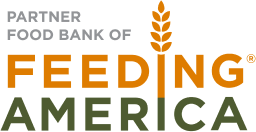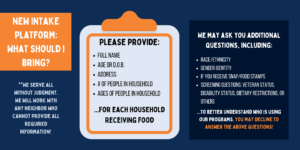By Amber Wright, Development and Marketing Coordinator
March is National Nutrition month, a topic intertwined with much of our work at The Foodbank. This is the perfect time to highlight the impact good nutrition has on our communities and the role it plays in our fight against hunger. In this blog, we will discuss the importance of a healthy diet and some of the challenges in accessing the right foods.
Food as the Foundation of Well-being
Food serves as more than just fuel. It also feeds our mind and soul, providing comfort, connection, and even tradition. However, its primary purpose is to provide our body with the things it needs to function. Diet-related diseases are the leading cause of death in the United States, even though the US ranks among the wealthiest countries in the world.
Despite claims that 81% of Americans know nutrition basics, a recent survey revealed that 91% of the general population lacks awareness of their daily protein, fiber, carbohydrates, sugar, and salt intake. This study also found that many Americans don’t prioritize nutritional values when dining out or cooking at home, rather focusing on staying within their budget and meal planning.
This does not mean most people are purposely choosing to eat poorly. Certain factors can lead to poor nutrition despite the best of intentions, including lack of money to afford healthier foods, not having access to a grocery store, and even poor nutritional literacy. Research by the Center for Disease Control (CDC) reported a significant portion of adults could not accurately read a standard nutrition label.
Food as Medicine
Food as medicine is a concept that addresses the interconnectedness of food and health. This congressionally funded initiative has spurred a collective movement to address the disparities in access to healthy and healing foods. This encompasses medically tailored meals, health-focused groceries, and produce prescription programs. The Foodbank partners with Dayton Children’s Hospital on one such initiative, known as the Food Script program. We also show a high priority on providing fresh fruits and vegetables, having distributed over 4.5 million pounds of produce last year alone.
While certain foods may trigger chronic conditions, others possess medicinal and protective qualities. Unfortunately, Western diets, often rich in processed foods and low in fresh produce, are deficient in vital vitamins and minerals. Clever marketing around fad diets and misleading health products add to the confusion. Consumers need a guide to see past the deception.
It’s crucial to dispel the notion that food alone can compensate for poor lifestyle choices or genetic predispositions. Food, however, does play a pivotal role in promoting or worsening health outcomes, emphasizing the need for a nutrient-dense diet featuring plenty of whole foods. Such a diet has been proven to prevent chronic diseases and aid in treating conditions like type 2 diabetes.
Nutritional Disparities and Access
Even if everyone gained a deep understanding of what makes a proper diet, there would still be barriers for many folks. People living in food deserts, where communities lack access to grocery stores selling healthy food at affordable prices (or at all), may not be able to access staples like fresh produce. If families lack transportation, they are forced to work with the cheap, low-nutrient foods sold at gas stations and convenience stores. Sometimes supermarkets are available, but lack of money causes people to purchase cheaper or less healthy options.
The consequences extend beyond individual health. There are societal repercussions like poor learning and behavior in children at school and economic impacts on adults, such as medical bills and lost wages from missing work. Insufficient nutrition leads to increased healthcare costs for both patients and taxpayers. The effects of poor nutrition are so severe and widespread, they were recently argued to be a threat to national security by some health experts.
The Role of Composting in Soil Health and Nutrition
Problems with nutrition exist at the very start of the food chain where produce is grown. Due to soil depletion, research has found that fruits and vegetables now contain less vitamins and minerals than they used to decades ago.
Shifting our focus to the broader picture, the importance of composting emerges as a sustainable solution, not just for reducing waste and lessening greenhouse gas emissions, but also for preserving nutrition. While more formal research is needed, experts suggest that composting not only enhances soil fertility but can also boost the nutrient content of produce grown in that soil.
The Foodbank operates an industrial composting system by Green Mountain Technologies that allows us to process 3 tons of food scraps each week. The nutrient-rich compost is then used in our 40 raised garden beds to grow the produce we distribute to our network of partner agencies, and though our direct services. This reduces our food waste and returns nutrients back to the soil instead of the landfill.
Conclusion
To address the challenges outlined above, it is imperative to advocate for policies that expand access to proper nutrition. Initiatives like the Supplemental Nutrition Assistance Program (SNAP), Women, Infants, and Children (WIC), The Emergency Food Assistance Program (TEFAP), the Commodity Supplemental Food Program (CSFP), and Kid’s Cafés play a crucial role in ensuring that individuals and families have access to healthy food options. These programs are our first line of defense against food insecurity.
The journey towards a healthier society involves understanding the intricate relationship between nutrition, access to healthy foods, and sustainable practices like composting. Let’s work together to bridge the gaps, educate our communities, and empower individuals to make informed choices that nourish not only their bodies but also the collective well-being of our society.





No comment yet, add your voice below!